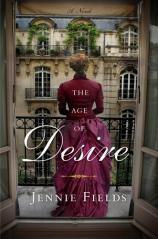The Age of Desire
Review
The Age of Desire
In her previous work, Jennie Fields has explored the role of sexuality in women's lives, particularly in their sense of self, freedom, and overall well being. As the title “The Age of Desire” might suggest, her latest novel continues to examine this theme. This time, however, the subject of Fields' inquiry is not an imaginary character, but rather the famous American novelist Edith Wharton.
"Those who already are familiar with Wharton's work will be inspired to return to the novels with a fresh perspective, while those who aren’t will be interested in coming to know this fascinating woman not only through her life but also through her work."
At a time when Freud's ideas were scandalous novelties, when to even speak of women --- let alone aristocratic women --- as sexual beings was akin to taboo, Edith Wharton's story was probably hardly unique. Married to a man who seemed suitable but who hardly evoked anything resembling passion, Edith --- whose marriage to Teddy Wharton is essentially sexless --- has convinced herself that she is not meant for sexual pleasure. "Some women are made for that sort of thing," she suggests at one point. "It seems perhaps…I am not."
But the year is 1907, and things are beginning, slowly but surely, to change. Edith's intellectual circle --- which includes the writer Henry James, among other notable personages --- is also open to bohemian personalities like Anna de Noailles, a young poet who writes about sensual themes and who shows up at dinner parties without a corset (or perhaps any other undergarments). Sex, passion and desire are becoming topics more open for discussion between men and women --- and discuss them Edith does, however reluctantly, with a new acquaintance: the stylish and flirtatious Morton Fullerton. Edith is undeniably attracted to Fullerton, but finds it difficult to trust the yearnings of her heart, let alone the unfamiliar yearnings of her body.
Edith's relationships with men are certainly at the center of Fields' novel, but just as central is her relationship with her long-time governess, secretary and companion Anna. Sections of the book are told from Anna's point of view, providing her outsider's perspective not only on Edith's life but also on the world to which Edith so comfortably belongs. The letters between Anna and Edith are the topic of a nonfiction book, MY DEAR GOVERNESS, also published this year, and Fields includes actual excerpts from Edith's letters and diary entries, giving the novel itself an aura of authenticity.
Readers will come away from THE AGE OF DESIRE with a feeling of understanding the life and work of Edith Wharton a bit better, along with the mindsets and mores that defined her world. Those who already are familiar with Wharton's work will be inspired to return to the novels with a fresh perspective, while those who aren’t will be interested in coming to know this fascinating woman not only through her life but also through her work.
Reviewed by Norah Piehl on August 3, 2012
The Age of Desire
- Publication Date: August 2, 2012
- Genres: Fiction, Historical Fiction
- Hardcover: 368 pages
- Publisher: Pamela Dorman Books
- ISBN-10: 067002368X
- ISBN-13: 9780670023684





